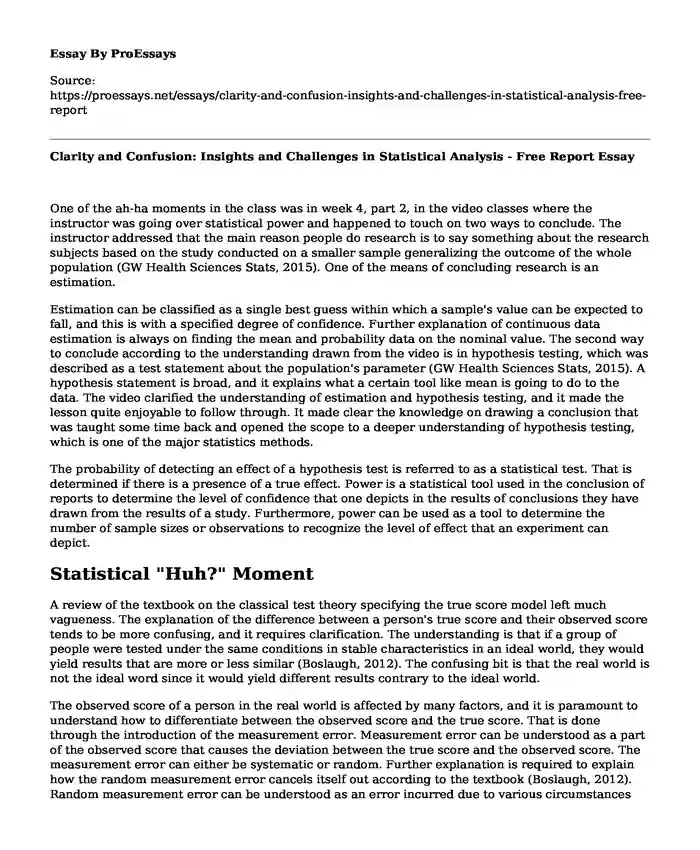One of the ah-ha moments in the class was in week 4, part 2, in the video classes where the instructor was going over statistical power and happened to touch on two ways to conclude. The instructor addressed that the main reason people do research is to say something about the research subjects based on the study conducted on a smaller sample generalizing the outcome of the whole population (GW Health Sciences Stats, 2015). One of the means of concluding research is an estimation.
Estimation can be classified as a single best guess within which a sample's value can be expected to fall, and this is with a specified degree of confidence. Further explanation of continuous data estimation is always on finding the mean and probability data on the nominal value. The second way to conclude according to the understanding drawn from the video is in hypothesis testing, which was described as a test statement about the population's parameter (GW Health Sciences Stats, 2015). A hypothesis statement is broad, and it explains what a certain tool like mean is going to do to the data. The video clarified the understanding of estimation and hypothesis testing, and it made the lesson quite enjoyable to follow through. It made clear the knowledge on drawing a conclusion that was taught some time back and opened the scope to a deeper understanding of hypothesis testing, which is one of the major statistics methods.
The probability of detecting an effect of a hypothesis test is referred to as a statistical test. That is determined if there is a presence of a true effect. Power is a statistical tool used in the conclusion of reports to determine the level of confidence that one depicts in the results of conclusions they have drawn from the results of a study. Furthermore, power can be used as a tool to determine the number of sample sizes or observations to recognize the level of effect that an experiment can depict.
Statistical "Huh?" Moment
A review of the textbook on the classical test theory specifying the true score model left much vagueness. The explanation of the difference between a person's true score and their observed score tends to be more confusing, and it requires clarification. The understanding is that if a group of people were tested under the same conditions in stable characteristics in an ideal world, they would yield results that are more or less similar (Boslaugh, 2012). The confusing bit is that the real world is not the ideal word since it would yield different results contrary to the ideal world.
The observed score of a person in the real world is affected by many factors, and it is paramount to understand how to differentiate between the observed score and the true score. That is done through the introduction of the measurement error. Measurement error can be understood as a part of the observed score that causes the deviation between the true score and the observed score. The measurement error can either be systematic or random. Further explanation is required to explain how the random measurement error cancels itself out according to the textbook (Boslaugh, 2012). Random measurement error can be understood as an error incurred due to various circumstances such as administrative procedure, a fluctuation in the alertness or mood of a person, and room temperature. On the other hand, systematic error is an error that keeps affecting the subject but is not tied to the construct in testing like poor language skills. Systematic error is referred to as a source of bias. In contrast, random error is not yet disadvantage the person in one way or the other.
References
Boslaugh, S. (2012). Statistics in a nutshell: A desktop quick reference. " O'Reilly Media, Inc.".
GW Health Sciences Stats. (2015). Hsci6263Biostats_Unit4b https://www.youtube.com/watch?v=CU8YDJZ76dY&feature=youtu.be&list=PL3W4UsZhmNzJP_7t07pTFvlySEQV1CXPL
Cite this page
Clarity and Confusion: Insights and Challenges in Statistical Analysis - Free Report. (2023, Dec 16). Retrieved from https://proessays.net/essays/clarity-and-confusion-insights-and-challenges-in-statistical-analysis-free-report
If you are the original author of this essay and no longer wish to have it published on the ProEssays website, please click below to request its removal:
- Steps of Library Search
- Ethnography for Social Science Research Paper Example
- Essay Example on Statistics: Math's Dominant Science for Data Analysis
- SWOT Analysis of Southwest Airlines
- Ethics in Qualitative Research: Challenges for Psychologists - Research Paper
- Statistical Analysis - Report Example
- Report Sample on Cost Comparison Analysis







